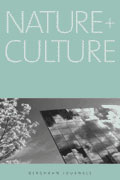
Nature and Culture
ISSN: 1558-6073 (print) • ISSN: 1558-5468 (online) • 3 issues per year
Editors:
Sing C. Chew, Helmholtz Centre for Environmental Research - UFZ
Matthias Gross, Helmholtz Centre for Environmental Research - UFZ and University of Jena
Daniel Sarabia, Roanoke College, USA
Subjects: Environmental Studies, Sociology, Anthropology, Archaeology
Latest Issue
Volume 20 Issue 3
Trusting Climate Science
The Process of Accepting What Is True About the Climate Crisis and Simultaneously Creating Social Order
This article develops a theoretical framework for trust in science. The framework is created to facilitate analysis of the growing environmental youth movement’s trust in and relation to climate science. This article provides a critical review of previous theoretical discussions of trust in science–public relations and recontextualizes and continues the discussion. This is accomplished by adopting a discourse analytical perspective on trust, knowledge production, and the construction of social order. The study shows how trust and the assessment of trustworthiness lie at the core of knowledge production and the construction of social order as well as how a problematization of trust as a truth-accepting practice is essential to understanding the growing environmental youth movement and its relation to science.
Modeling Spaces of Vulnerability into the Vulnerability of Place through Geoethical Dilemmas and Noosphere Dynamics
This article aims to explore the assumptions and implications of the iconic representations of human–geosphere intersections using geopolitical theology concepts to overcome the current mathematization of space as the main impediment to achieve spatial justice. Based on the ideas of noosphere and pneumatosphere, developed by the prominent Slavic figures of the 20th century, V.I. Vernadsky and P. Florenski, the authors suggest that geoethical dilemmas as backcasting prospective modeling may help to explore contingent scenarios that go beyond institutional frameworks and political ecology analysis. The article describes the current situation in human–geosphere intersections and explores the problem of mathematical models as a scapegoat to deal with ontological uncertainty, and finitude as the main problem of the Anthropocene based on the cultural paradigm of Technopoly.
Decoding the Cyclical Nexus of Cultural Landscape Transformations on Indigenous Lifestyles and Practices
Amid accelerating environmental and socioeconomic shifts, cultural landscapes and Indigenous lifestyles form a dynamic, reciprocal system, continuously reshaping each other. This article presents a conceptual framework exploring how transformations in cultural landscapes influence Indigenous practices, which in turn shape future landscape evolution. The framework operates across three interconnected levels: external forces, landscape changes, and community effects, emphasizing interaction pathways and feedback loops. Through systematic application to the Balinese Subak system, this study demonstrates the framework’s utility in decoding complex transformation processes. Key findings reveal that communities maintain cultural continuity through dynamic knowledge integration combining traditional wisdom with modern innovations. Rather than simple replacement, hybridization processes create social-ecological arrangements maintaining both cultural integrity and adaptive capacity, informing policy and conservation strategies for cultural landscape management.
Becoming-With Pewen
Understanding Human–Tree Entanglements and Their Implications for Conservation
Pewen (
“We” Live in a Time
Storying the Futures and Pasts of Environmental Crisis
Gina Caison. 2024.
Jonathan Staal. 2024.